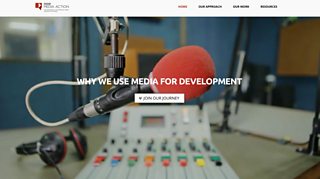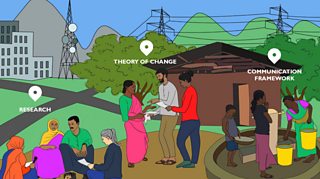How to use media for development - and why it works.
Clemency Fraser
Senior Production Manager, �������� Media Action
Have you ever wanted to see ? Well, good news folks now you can.
�������� Media Action has been creating innovative and effective media for development across the globe since the 1990s – it’s been quite a journey. Of course, we’ve sometimes learnt lessons the hard way but we’ve also had phenomenal successes. Here are a few.
More than 200 million people a year watch or listen to our programmes – we know that those who listen to or watch our topical debate and discussion programmes know more about politics, discuss politics more, and participate more in politics. We know well-designed and relevant TV and radio health programmes can motivate people to improve their health – and we have some excellent data on how our reality TV programmes have prompted people to take action to protect themselves against extreme weather and natural disaster.
Our gives you an insider’s look at how we use media as an effective tool for development. By sharing our approach we want to help more practitioners - beyond �������� Media Action - put this into practice too. We hope this will help deliver more media projects around the world and make a lasting impact for millions of people. Our motto.
The very best way to find out more is to , but you can find a whistle-stop tour of our approach below.

Through the lens
We use communication as aid – making media for those affected by a humanitarian crisis not about them – whether in or reaching those living in a warzone or .
Here’s how a reality TV show helped and how a radio programme helped people grow crops and .
Drama can stimulate community discussion, model how people can settle conflicts and help people to understand their rights, see how with .
Watch how our radio project in Ethiopia tackles the dangers of pregnancy and childbirth for women and their babies by communicating to both women – and men.
Behind the scenes
It may all seem lights, camera and action but in reality, the foundation of each of our projects is firmly rooted in and the ‘’.
This helps us focus on the impact we want the project to have. It enables us to develop strategies and identify issues, obstacles, opportunities and solutions to problems more effectively.

Once the theory of change is established, it’s onto the practical plan. Creative briefs feed into what we call a – so we can see how everything fits together before making the magic happen.
Sometimes you’ll discover traditional media – TV or radio - just isn’t going to work. And that’s when it’s time to think differently.
For instance, when 88% of your audience live in rural areas in India, 70% are illiterate and only 18% watch TV and 11% listen to radio – you have to get creative with .
If a country’s media is collapsing and being taken over by political armed groups - how do people know what information to believe and where to find it? See how our journalism training programme called to provide trusted information and a forum for dialogue for Libyans during a deteriorating political situation.
So why does it work?
Simply because media has the power to connect, engage and empower people to take action to improve their own lives. If done at scale, it can be achieved for less – per person – than the cost of a can of cola. We're not kidding, you can read more from my colleague
We hope the new website will give you valuable insight on the different ways media and communications can be used for good.
The includes , examples of our policy briefings, detailed research and to help you explore the way we research, design and deliver an audience-driven media project to reach millions of people - and most importantly make an effective and lasting impact on their lives.
No doubt �������� Media Action will continue to learn, grow and adapt - we hope you do too.
Now, embark on your own journey – .
